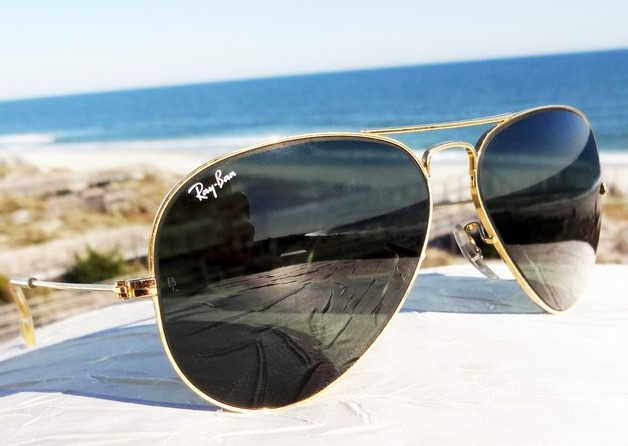The history of sunglasses spans centuries and cultures, evolving from simple protective devices to essential fashion accessories and advanced technological tools. The need for sunglasses originated in the ancient Arctic, where people prevented snow blindness by using primitive goggles that limited exposure to sunlight and its harsh glare reflecting off snow and ice. History tell that some Chinese people conceal their facial expressions by using an early version of sunglasses, made out of smoky quartz, and that some Roman emperors watched gladiator fights through polish emeralds glasses.
Fast forward to contemporary times, and you might wonder where the term “polarized” originated. In the 1930s, Polaroid invented polarized lenses, which filter out horizontal light waves, making them particularly useful for outdoor activities and driving. It wasn’t until World War II that aviator sunglasses were developed, becoming iconic and remaining popular to this day.
From a very young age, I recognized the importance and benefits of wearing sunglasses. Perhaps it was the influence of MTV and pop culture’s marketing that made me want to emulate the rockstars of the late ’90s and early 2000s. Initially, my motivation might have been to look cool with a stylish pair of sunglasses. However, I soon realized that the technology behind the lenses truly matters, especially when engaging in outdoor sports like beach volleyball, cycling, or surfing.
Just as you have different types of silverware at home—forks, various spoon sizes, and specialized knives for particular tasks—you wouldn’t use a fork to eat soup, as it would take forever. Instead, you use the correct spoon to enjoy it. For me, sunglasses are the same. Although all of them enhance my vision, I have several pairs to meet specific needs. For example, my “cycling” sunglasses are specifically for cycling, and perhaps for running or exercising as well. However, these futuristic, cyclops-looking sunglasses are definitely not something I would wear casually.

Rayban – Aviator Classic
Despite of their origins and history these lenses are bold, sexy and effective. No wonder why celebrities, and the mass in general, keep wearing these iconic pair of shades. Continue reading…
Oakley – Holbrook
Based on the numerous times I’ve purchased these sunglasses, they are undoubtedly in my top 3 all-time favorites. The Shaun White model in black and gold sparked my love for these shades. Today, I own a pair of Holbrook sunglasses that I use to filter harmful blue light from screens,
Functions of Sunglasses
Sunglasses serve several important functions beyond just being a fashion accessory. They provide protection from harmful ultraviolet (UV) rays, which can cause long-term damage to the eyes, such as cataracts and macular degeneration. By reducing glare from reflective surfaces like water, snow, and roads, sunglasses enhance visual comfort and safety, especially while driving. Additionally, they improve visual clarity and contrast, making it easier to see in bright conditions. Sunglasses also reduce eye strain and fatigue caused by squinting in bright light, making them essential for eye comfort.
Technology in Sunglasses
Modern sunglasses incorporate various advanced technologies to enhance their functionality. Polarized lenses filter out horizontal light waves, reducing glare and improving visual clarity. Photochromic lenses automatically adjust their tint based on the amount of UV light exposure, providing optimal vision in varying light conditions. Anti-reflective coatings reduce reflections from the front and back surfaces of the lenses, improving visual clarity and reducing eye strain. Some sunglasses are designed to filter out blue light from digital screens, which can help reduce eye strain and improve sleep quality. Additionally, impact-resistant materials like polycarbonate and Trivex are used to make lenses that are highly resistant to impact, providing better protection for the eyes. Hydrophobic and oleophobic coatings repel water and oil, making the lenses easier to clean and maintain.
Standards for Sunglasses
To ensure the effectiveness and safety of sunglasses, various standards and regulations are in place. Sunglasses should block 100% of UVA and UVB rays, and labels indicating UV400 protection are a good indicator of this. The American National Standards Institute (ANSI) Z80.3 standard specifies requirements for non-prescription sunglasses and fashion eyewear, including impact resistance and optical quality. The international standard ISO 12312-1 specifies the requirements for sunglasses and related eyewear, including UV protection, optical properties, and mechanical strength. In Europe, sunglasses must comply with the European Directive 89/686/EEC and bear the CE mark, indicating they meet health, safety, and environmental protection standards. In the United States, the Food and Drug Administration (FDA) regulates sunglasses as medical devices, ensuring they meet specific safety and performance criteria.
Types of Sunglasses
There are various types of sunglasses available, each suited to different styles and needs. Aviator sunglasses, characterized by their thin wire frames and large teardrop-shaped lenses, offer excellent coverage and a classic style. Wayfarer sunglasses, known for their distinctive trapezoidal shape and thick frames, are a versatile and timeless choice. Sport sunglasses are designed for active use, featuring wraparound frames and lenses for maximum coverage and stability. Round sunglasses, with their circular lenses and frames, offer a retro and stylish look. Oversized sunglasses provide extensive coverage and make a bold fashion statement with their large lenses and frames. Cat-eye sunglasses, featuring upswept outer edges, add a touch of glamour and are a fashionable choice.
Choosing the Right Sunglasses
When selecting sunglasses, it’s important to consider several factors to ensure you get the best pair for your needs. Ensure the sunglasses offer 100% UV protection to safeguard your eyes from harmful rays. Choose polarized lenses for glare reduction or photochromic lenses for varying light conditions. Select a frame style that complements your face shape and personal style. Additionally, consider the activities you’ll be engaging in; for example, sport sunglasses are ideal for outdoor adventures, while fashion sunglasses are perfect for everyday wear.